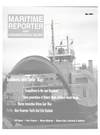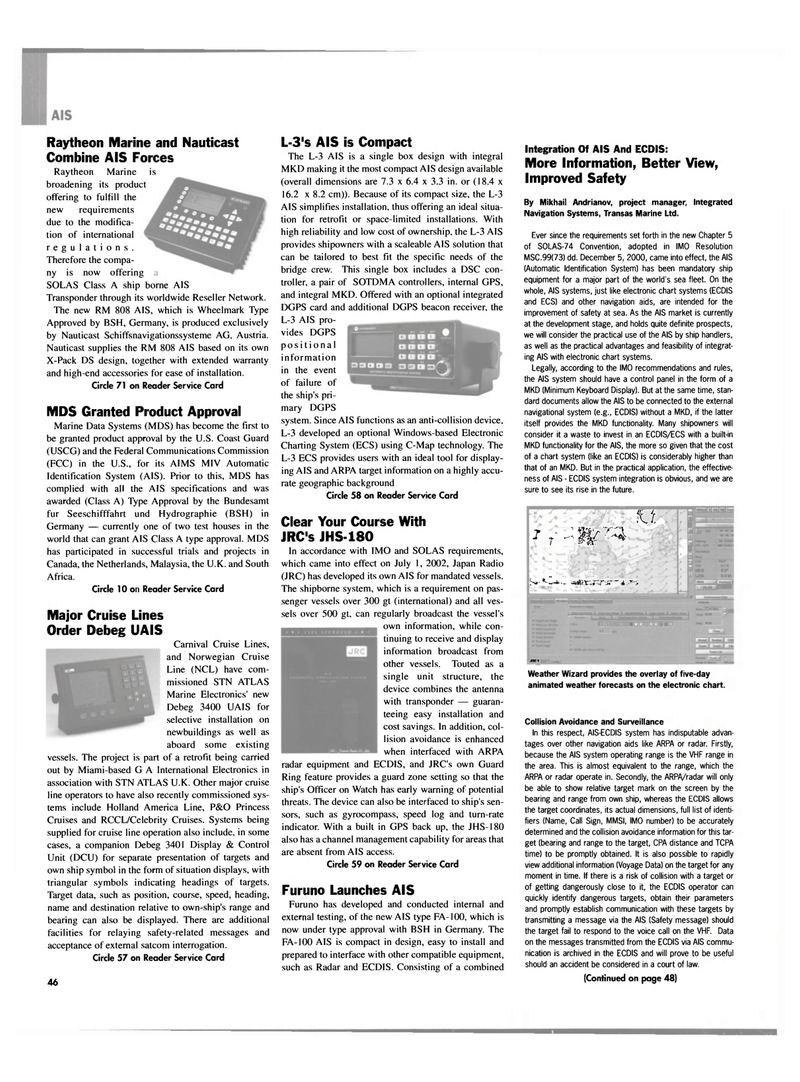
Page 44: of Maritime Reporter Magazine (May 2003)
Read this page in Pdf, Flash or Html5 edition of May 2003 Maritime Reporter Magazine
Raytheon Marine and Nauticast
Combine AIS Forces
Raytheon Marine is broadening its product offering to fulfill the new requirements due to the modifica- tion of international regulations.
Therefore the compa- ny is now offering
SOLAS Class A ship borne AIS
Transponder through its worldwide Reseller Network.
The new RM 808 AIS, which is Wheelmark Type
Approved by BSH, Germany, is produced exclusively by Nauticast Schiffsnavigationssysteme AG, Austria.
Nauticast supplies the RM 808 AIS based on its own
X-Pack DS design, together with extended warranty and high-end accessories for ease of installation.
Circle 71 on Reader Service Card
MDS Granted Product Approval
Marine Data Systems (MDS) has become the first to be granted product approval by the U.S. Coast Guard (USCG) and the Federal Communications Commission (FCC) in the U.S., for its AIMS MIV Automatic
Identification System (AIS). Prior to this, MDS has complied with all the AIS specifications and was awarded (Class A) Type Approval by the Bundesamt fur Seeschifffahrt und Hydrographie (BSH) in
Germany — currently one of two test houses in the world that can grant AIS Class A type approval. MDS has participated in successful trials and projects in
Canada, the Netherlands, Malaysia, the U.K. and South
Africa.
Circle 10 on Reader Service Card
Major Cruise Lines
Order Debeg UAIS _ Carnival Cruise Lines, and Norwegian Cruise
Line (NCL) have com- missioned STN ATLAS
Marine Electronics' new
Debeg 3400 UAIS for selective installation on newbuildings as well as aboard some existing vessels. The project is part of a retrofit being carried out by Miami-based G A International Electronics in association with STN ATLAS U.K. Other major cruise line operators to have also recently commissioned sys- tems include Holland America Line, P&O Princess
Cruises and RCCL/Celebrity Cruises. Systems being supplied for cruise line operation also include, in some cases, a companion Debeg 3401 Display & Control
Unit (DCU) for separate presentation of targets and own ship symbol in the form of situation displays, with triangular symbols indicating headings of targets.
Target data, such as position, course, speed, heading, name and destination relative to own-ship's range and bearing can also be displayed. There are additional facilities for relaying safety-related messages and acceptance of external satcom interrogation.
Circle 57 on Reader Service Card 46
L-3's AIS is Compact
The L-3 AIS is a single box design with integral
MKD making it the most compact AIS design available (overall dimensions are 7.3 x 6.4 x 3.3 in. or (18.4 x 16.2 x 8.2 cm)). Because of its compact size, the L-3
AIS simplifies installation, thus offering an ideal situa- tion for retrofit or space-limited installations. With high reliability and low cost of ownership, the L-3 AIS provides shipowners with a scaleable AIS solution that can be tailored to best fit the specific needs of the bridge crew. This single box includes a DSC con- troller, a pair of SOTDMA controllers, internal GPS, and integral MKD. Offered with an optional integrated
DGPS card and additional DGPS beacon receiver, the
L-3 AIS pro- vides DGPS positional information in the event of failure of the ship's pri- mary DGPS system. Since AIS functions as an anti-collision device,
L-3 developed an optional Windows-based Electronic
Charting System (ECS) using C-Map technology. The
L-3 ECS provides users with an ideal tool for display- ing AIS and ARPA target information on a highly accu- rate geographic background
Circle 58 on Reader Service Card
Clear Your Course With
JRC's JHS-180
In accordance with IMO and SOLAS requirements, which came into effect on July 1, 2002, Japan Radio (JRC) has developed its own AIS for mandated vessels.
The shipborne system, which is a requirement on pas- senger vessels over 300 gt (international) and all ves- sels over 500 gt, can regularly broadcast the vessel's own information, while con- tinuing to receive and display information broadcast from other vessels. Touted as a single unit structure, the device combines the antenna with transponder — guaran- teeing easy installation and cost savings. In addition, col- lision avoidance is enhanced when interfaced with ARPA radar equipment and ECDIS, and JRC's own Guard
Ring feature provides a guard zone setting so that the ship's Officer on Watch has early warning of potential threats. The device can also be interfaced to ship's sen- sors, such as gyrocompass, speed log and turn-rate indicator. With a built in GPS back up, the JHS-180 also has a channel management capability for areas that are absent from AIS access.
Circle 59 on Reader Service Card
Furuno Launches AIS
Furuno has developed and conducted internal and external testing, of the new AIS type FA-100, which is now under type approval with BSH in Germany. The
FA-100 AIS is compact in design, easy to install and prepared to interface with other compatible equipment, such as Radar and ECDIS. Consisting of a combined
Integration Of AIS And ECDIS:
More Information, Better View,
Improved Safety
By Mikhail Andrianov, project manager, Integrated
Navigation Systems, Transas Marine Ltd.
Ever since the requirements set forth in the new Chapter 5 of S0LAS-74 Convention, adopted in IMO Resolution
MSC.99(73) dd. December 5, 2000, came into effect, the AIS (Automatic Identification System) has been mandatory ship equipment for a major part of the world's sea fleet. On the whole, AIS systems, just like electronic chart systems (ECDIS and ECS) and other navigation aids, are intended for the improvement of safety at sea. As the AIS market is currently at the development stage, and holds quite definite prospects, we will consider the practical use of the AIS by ship handlers, as well as the practical advantages and feasibility of integrat- ing AIS with electronic chart systems.
Legally, according to the IMO recommendations and rules, the AIS system should have a control panel in the form of a
MKD (Minimum Keyboard Display). But at the same time, stan- dard documents allow the AIS to be connected to the external navigational system (e.g., ECDIS) without a MKD, if the latter itself provides the MKD functionality. Many shipowners will consider it a waste to invest in an ECDIS/ECS with a built-in
MKD functionality for the AIS, the more so given that the cost of a chart system (like an ECDIS) is considerably higher than that of an MKD. But in the practical application, the effective- ness of AIS - ECDIS system integration is obvious, and we are sure to see its rise in the future. u
T'f ^rfjfTZl m. Wi .. ^sT-v i . v*. 1LH|
Weather Wizard provides the overlay of five-day animated weather forecasts on the electronic chart.
Collision Avoidance and Surveillance
In this respect, AIS-ECDIS system has indisputable advan- tages over other navigation aids like ARPA or radar. Firstly, because the AIS system operating range is the VHF range in the area. This is almost equivalent to the range, which the
ARPA or radar operate in. Secondly, the ARPAAadar will only be able to show relative target mark on the screen by the bearing and range from own ship, whereas the ECDIS allows the target coordinates, its actual dimensions, full list of identi- fiers (Name, Call Sign, MMSI, IMO number) to be accurately determined and the collision avoidance information for this tar- get (bearing and range to the target, CPA distance and TCPA time) to be promptly obtained. It is also possible to rapidly view additional information (Voyage Data) on the target for any moment in time. If there is a risk of collision with a target or of getting dangerously close to it, the ECDIS operator can quickly identify dangerous targets, obtain their parameters and promptly establish communication with these targets by transmitting a message via the AIS (Safety message) should the target fail to respond to the voice call on the VHF. Data on the messages transmitted from the ECDIS via AIS commu- nication is archived in the ECDIS and will prove to be useful should an accident be considered in a court of law. (Continued on page 48)

 43
43

 45
45
